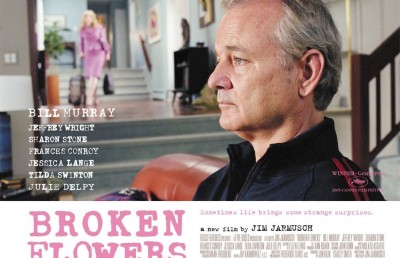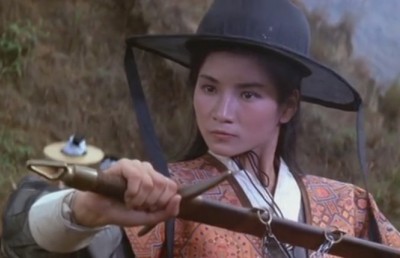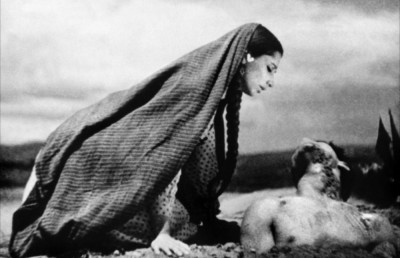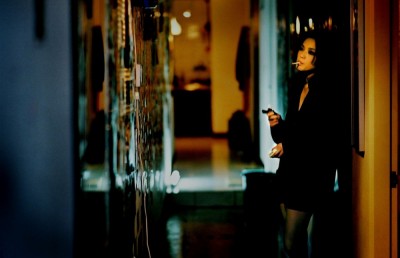Cinefest 26
Variations on a Love Triangle
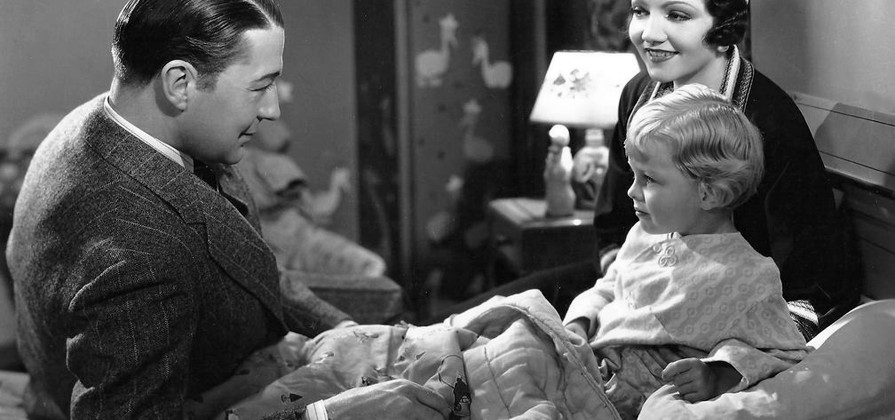
March 16-19 marked the dates of the 26th instalment of the Syracuse-based film festival of silent and early sound feature and short films, Cinefest. Now four years after the death of its founder Phil Serling, Cinefest is still alive and kicking, with a menu of rare and odd films which you will not find at your local video store or repertoire theatre. Although the attendance seemed down from its peak years, based on the ease of finding a seat in the hotel’s improvised screening room, the enthusiasm and energy for the films on display, lacking in the years immediately following Serling’s death, seemed back to its usual levels.
As the norm, the focus of the festival is on American films, with only one non-Anglophone film, the German Backstreet, including the few British films thrown into the mix. Such a high emphasis on American films is only natural given the source for many of these films are collections based in the US, but this trend toward very few (in some years none) foreign films is also, perhaps, a by-product of certain people who were instrumental in procuring these foreign titles no longer being involved with Cinefest, such as William K. Everson (deceased), Paolo Cherchi Usai, and Chris Horak.

One of the highlights of the festivals was the rarely seen Frank Capra film, Submarine, made in 1928 with a synchronized score. [1] Cinefest screened the silent version, which switched over to the synchronized score for about ten or so minutes near the end. Like The Cock-Eyed World, this is another buddy film with two submarine corporals, Jack Holt (actor Jack Reagon) and Ralph Graves (Bob Mason), sleeping with and vying for the same women, only in this case the competition is far more complex than in the usual love triangle. All the navy and marine footage is excellent, but the real sparks come from the intense male rivalry between the two leads. The best is left for the final third of the film, which culminates in a morally ambiguous climax in which the older corporeal, Jack, whose underwater diving prowess is established early in the film, only decides to save a dying group of men trapped in a marooned submarine when it suits his personal interests, which involves learning the truth behind Ralph having slept with his wife. To back pedal the plot, Jack and Ralph grow distant and alienated from each other after Jack marries Bessie (Dorothy Revier). At first chance, Bessie sleeps with Jack’s best friend Ralph, who is unaware that the woman is married, let alone to his once best friend. After the fling Ralph returns to work on the ill-fated submarine, which is struck by a ship and descends 400 feet to the bottom of the ocean. The airless and stifling conditions in the sunken submarine lead to imagery of shirtless, sweaty, muscular men, gasping for what little air is left, some collapsing from exhaustion, others managing to sustain their life system. Only when Jack realizes that Ralph was merely a pawn in his wife’s sexual escapades, does he take the plunge and rescue the men in the submarine. The film concludes with the two men on the beach, the ex-wife seen enjoying the company of another “big boy.” The sense one gets from this ending is: who needs women when you have a submarine load of sweaty, muscular men to pick from!
The Man From Yesterday (1932, Berthold Viertel) –which offers a novel twist on the ‘love triangle’ theme– gets my vote for this year’s best film of the festival. Directed by Austrian born Viertel, the film’s visual style, handled by cinematography Karl Struss, was the most expressionistic of all films screened this year (except of course the one German film Backstairs). Claudette Colbert plays a wartime nurse, Sylvia Suffolk, who falls quickly in love with British soldier Tony Clyde (Clive Brooks), and marries him before he goes off to the front. She receives notice of his death in the line of duty, when in fact he has merely been injured and gone missing. In the interim Sylvia has Tony’s child, and, after mourning for the requisite amount of cinema time, meets and falls in love with suave French army doctor Rene Gaudin, played by Charles Boyer. Things are going fine until they happen to vacation at the same resort which houses the Army hotel where Tony has been recuperating from post-war trauma. After some suspenseful build-up leading to the shocking revelation, Sylvia is placed on the proverbial cross, forced to decide between her loyalty to her first love and father of her child, Tony, and her more passionate, recent love, Rene. What is ostensibly a well-worn plot machination is raised to a high level by the film’s visual style, which plays variations on silhouettes and shadows as a metaphor for Tony as a “forgotten soldier” or “walking dead”. The first time we see the ‘reborn’ Tony, cinematographer Struss’ lighting and camera underscores this thematic motif of the ‘forgotten soldier’: The shot begins on a medium shot of a figure’s shadow on the wall. We can make out the profile of a man smoking. The camera then begins to dolly back slowly, revealing Tony as a ‘living’ dead, a literal “shadow of his former self.” Rene is the first to realize that Tony is still alive, in a wonderful scene where the two men meet in the hotel courtyard in complete silhouette. Tony, who has already seen his wife together with Rene, initiates the conversation. The scene is handled in striking fashion: the silhouetted darkness breaks when Rene lights a match for Tony, which enables him to see his face and realize that Sylvia’s first husband is still alive. The use of silhouette here establishes once again the visual pattern of depicting Tony as a ‘forgotten/missing soldier’ obscured in symbolic dark shadow. Tony even begins to act and talk like a ‘mechanical’ man (a somewhat ironic gesture given how I always thought of Clive Brooks as a ‘wooden’ performer). As he tellingly informs Sylvia, “Nothing is the same after war.” Once placed in this torturous position Sylvia is also given an appropriately expressionist visual treatment, framed behind a door echoing a surrogate prison. For the neutral observer the choice between the cool, stoic Englishman Brooks and the passionate Frenchman Boyer –although he was less fluid in this, only his second English speaking role– should be an obvious one. However, realising that Tony is dying, Sylvia decides to marry and comfort Tony until his death, which comes in dramatic fashion. By this point Tony has become a lifeless, soulless walking dead, to the point where his expressionless face frightens a lady in a bar, moments before Tony dies in the street. When someone asks how he died the response foreshadows the spirit of the famous final line at the end of King Kong (“Twas beauty that killed the beast”): “He died in the war, that’s how.” To my knowledge this is the first North American film that depicts the returning soldier as a metaphorical ‘zombie’ (a physical shell of his former self), foreshadowing later horror films (American and European) that would develop this theme for both horrific and political import in a direct war context (Deathdream, Canada, Bob Clark, 1974, The Homecoming, Joe Dante, 2005), or in less specific contexts (Night of the Living Dead, Dawn of the Dead, Land of the Dead, George Romero, 1968, 1979, 2005, Dead Creatures, UK, Andrew Parkinson, 2001, Shaun of the Dead, UK, Edgar Wright, 2004, Les Revenants??/??They Came Back, France, 2004 Robin Campillo).
As pessimistic as The Man from Yesterday is, it is a feel good movie compared to the one German film showing this year, the Leopold Jessner and Paul Leni directed and Carl Mayer scripted Backstairs (Hintertreppe). Seeing this Teutonic miserabalist drama amidst three days of cheery, generally uplifting Hollywood fare made it seem….refreshing! It is also instructive to compare this film’s treatment of the love triangle theme against the several noted American films as a barometer for how culturally different the aesthetic propensities of these two powerhouse (at the time) film nations were. The love triangle in this situation involves a maid (Henny Porten), her construction worker fiancée, played by future director William Dieterle, and an unusually tall, deformed mailman (Fritz Korner). The whole ‘affair’ takes place within the oppressive confines of a tenement, and specifically the buildings stylized staircase, the courtyard, and the roof (where the maid jumps to her suicide at the film’s conclusion). The film’s pace, strikingly ponderous and lugubrious even for an Expressionist film, suggests as strong an influence from Kammerspiel theatre as Expressionism. In fact, in her authoritative book The Haunted Screen Lotte Eisner refers to this as a “Kammerspiele before its time” (p. 177). In one striking moment a door opens giving us a quick glimpse of the mailman about to brandish an axe against the maid’s fiancée. Unlike the other love triangle films, where the usual price to pay is a broken heart, or at worse a tragic yet dramatically necessary death, in Backstairs no one gets out alive!
Either by programming choice or coincidence, the depressive Backstairs was thankfully followed by the delightful ‘thrill’ comedy featurette Hold Your Breath. The crux of this comedy is the long, Harold Lloyd-esque scene of a character positioned perilously on the window ledge of a skyscraper. The big difference here is that a) The person is a woman, the main comedienne of the Al Christie studios, Dorothy Devore, and b) While with Lloyd, or other male-centered thrill comedies, the character finds himself on the ledge (or girder) through some accident or misguided design, here the Devore character, Mabel, is out on the ledge of her own accord! Why? An organ grinder’s monkey whisks off through an open window with a $50,000 bracelet, and when Mabel is accused by the bracelet’s millionaire owner of stealing the bracelet she goes off onto the ledge in pursuit of the monkey. What makes the scene especially inventive is that as much of the humor comes from the attitude of the crowd that forms at street level as from the high altitude gags themselves. For example, the nose bleed drama goes on for so long that the audience becomes bored, one man lamenting to his wife that if she (Mabel) doesn’t fall soon they will “miss tea break”. A street merchant, played by the irrepressible Max Davidson, profits from the situation by selling chairs, binoculars, etc.
As this film would suggest, comedy is always a Cinefest strong point, and another of this year’s comic highpoints –if you like Our Gang that is– is the trilogy of Our Gang silent shorts, Fire Fighters (1922), The Sunn Down Limited (1924) and Ten Years Old (1927). The best were the first and third, with the first including the Gang ‘playing’ adults as they build a fire engine out of a moonshine still (which leads to a scene of drunk animals flaying about in slow motion), and the third filled with clever gadget gags (like a train powered by a dog on a treadmill teased to run on the spot by a cat that is enticingly placed in a cage just out of the dog’s reach) and a birthday cake made by the Gang with every conceivable ingredient, but (barely) the proverbial kitchen sink.
Although not strictly speaking a comedy, the best moments in The Return of Jimmy Valentine (1936, Lewis D. Collins) were the comic interludes. The Return of Jimmy Valentine sees the return of the fictional anti-hero Jimmy Valentine, who had already appeared in three films prior to this one, all entitled Alias Jimmy Valentine from 1915, 1920, and 1928. Reprising his role from the 1915 version is Robert Warwick as Valentine. The original from 1915 by Maurice Tourneur was an important early gangster film in which Warwick played the title character of the infamous safecracker. This time Warwick plays a retired Jimmy Valentine being hounded by nosey newspaper reporters and, more worryingly, a former accomplice, played menacingly by J. Carroll Naish, who wants to avenge his father’s death, which he blames on Valentine. Rather than streamlining this as a crime film, director Collins blends the gangster film, the newspaper film, and bits of vaudevillian comedy to concoct a pleasurable drama, at times resembling a screwball comedy with its breezy dialogue. In fact the serious material is upstaged by the comedic turns of Edgar “Slow Burn” Kennedy as the hapless hotel house detective Callahan and the lead reporter’s (Roger Pryor) imbecilic sidekick ‘Red’ Dolan, played (I think) by Wade Boteler. Comic highpoints include a scene clearly inspired by Kennedy’s hat-switch duel with Harpo in Duck Soup (1933), in this case a cigar and cigarette replacing the hats; and a hilariously ludicrous scene where the two men are handcuffed to each other and in the process of trying to extricate themselves Dolan ends up wearing Callahan’s jacket!
The spirit of William K. Everson, haunting Cinefest since his death in 1996, made an appearance this year as a young interviewer in a 1957 television show celebrating Broncho Billy Anderson, the cinema’s first western star, which was screened as part of Cinefest’s tribute to Anderson. The clunky format of this early television documentary featured a static camera forever locked on the subject, leaving Everson’s presence as a disembodied off screen voice. I lost hope in ever getting to see Everson on camera, until the film finally cut to another camera angle which showed Everson –already looking old in 1957!– seated next to the elderly silent star. Anderson, at first nervous and awkward in front of the new medium, eventually warms up and makes an engaging oral historian of his role in the development of early cinema and westerns. Anderson was instructive when talking about the early days, but veers close to the ludicrous when he goes on a tirade against ‘serious’ television shows such as Playhouse 90 and Climax, and offers his view that all drama should be aimed at the level of a ten year (like his westerns)! The tribute included two Anderson films, the short Broncho Billy and the Baby and an abridged version of a 1918 feature he directed and starred in, Shootin’ Mad.

Seen within the current political context, the somewhat “pro-Muslim” Seahawk (Frank Lloyd, 1924) struck a more responsive chord than it may have otherwise. English gentry Sir Oliver Tressilian (Milton Sills) is kidnapped by a pirate ship captained by a slumbering Wallace Beery, and then captured and enslaved by the Spaniards, who are in turn attacked by a Moors ship (“the fighting Basha of Algiers”). When Sir Oliver witnesses first hand the cruelty and inhumanity of the Spaniards toward other Christians he renounces his Christianity and assumes a new identity under the Moors as ‘Sakr-el-Bahr,’ the Sea Hawk –“the Moslem scourge of Christendom.” Back home his conniving, weak half-brother has conspired to get Sir Oliver convicted for a murder he himself committed. After an extended sequence detailing the Sea Hawk’s immersion into Arabic culture, where we learn that they deal in human slavery as flagrantly as the Spaniards, including the selling of Sir Oliver’s English love interest, Rosamund Godolphin (Enid Bennett), the film climaxes with Sir Oliver/Sakr-el-Bahr clearing his name after exposing his half-brother as the real murderer. By most accounts this version is the most faithful adaptation of the Rafael Sabatini novel from 1915. For an analysis of the film’s production history, go to the moviediva site’s review
For those who enjoy the popular melodrama sub-genre of the suffering woman, there were two impressive films on view this year, The Market of Vaine Desire (1916 Reginald Barker) and The Strange Case of Clara Deane (Louis Gasnier and Max Marcin, 1932). Vaine Desire is an engaging treatment of the ways in which a woman can go ‘wrong’ by making the rather brave parallel between a prostitute who sells her body for money and a ‘respectable’ woman who marries into wealth. In this case Claire Williams (who played a similar ‘virginal’ type in Hell’s Hinges made in the same year, a woman named Faith who transforms gunslinger William S. Hart to the side of the angels) is a woman, Helen Badgley, bullied by her status seeking mother (Gertrude Claire) into marrying an oily Count Bernard d’Montaigne, played by Charles Miller (complete with twirling moustache and evil goatee, and who looks strikingly similar to Alfred Hollingsworth, who plays a similar villainous character in Hell’s Hinges, the Mexican Silk Miller). The power of the crosscut was in full evidence by 1916, in the film’s most powerful scene, which cuts between Claire’s joyless engagement dinner, and the Count, dressed in all-black, wining and dining with a party of single women. In one delicious gesture, one of the floozies places a lampshade on the Count’s head, making him look suspiciously like a sultan.
In The Strange Case of Clara Deane Pat O’Brien, who also appeared as a boxer in The Personality Kid (1934, Alan Crosland), plays one of the heel’s of the festival in this tearjerker starring Wynne Gibson (who also starred in Michael O’Halloran) as the naive titular Deane, who falls for the smarmy affections of dubious insurance salesman Frank Deane (O’Brien). The film begins strikingly enough from a stylistic viewpoint, with tracking camera movements (DP by Henry Sharp) in the opening four establishing shots, on a street, toward a storefront, and inside a clothing store. In 1912 Clara Deane quits her successful career as a designer to marry Frank, who promptly casts her aside like last year’s luggage. While she is at the hospital giving birth to their first child, Frank plays poker instead. Frank eventually takes to petty crime and robs a gas station with his wife and young daughter, Nancy, in the car outside. Clara becomes an unwitting accomplice and is arrested for 30 years hard labor, along with her husband (who does not even attempt to exonerate his wife). While they are incarcerated the well meaning police detective Garrison (Dudley Digges), who had always coveted Clara’s daughter, ends up adopting the daughter (as an adult Nancy is played by Frances Dee). Clara is pardoned after twenty years, and the rest of the film is a fairly predictable, if effective, playing out of Clara being pursued once again by an unrepentant Frank once he is released from jail, and her ebbing toward the inevitable realization that Garrison adopted her daughter Nancy. The drama is spiced with some interesting visual touches, such as the odd unusual angle, or expressive camera movement, like the track in/zoom-in to Nancy at a schoolyard in the scene where Clara says goodbye to her young daughter before going off to jail. As Clara begins to leave the camera tracks right following the daughter crying after her mother, “Mommy, don’t leave me.” And another well choreographed camera movement occurs after Clara is released from prison, in a scene where she is walking along a building corridor, with the camera tracking her, and casually bumps into a young woman who is, unbeknownst to her, her adult daughter Nancy. Thankfully, Frank gets his just due in the final scene. After Frank learns that his daughter has been adopted by Garrison he plans to blackmail him by threatening to tell Nancy who her real parents are. Frank plans this on the eve of Nancy’s wedding night, but is shot dead by Clara on the ground’s of Garrison’s home. The police detective Garrison rushes to the grounds after hearing the gunshots, and covers up for Clara’s murder. The film concludes with a pseudo happy ending: in the final scene we see Nancy, still unaware of her familial past, being helped with her wedding dress by a contented Clara.
Cinefest usually saves a fun film for the late night Saturday slot, and this year was no exception with the 1930 William K. Howard crime yarn, Scotland Yard. This one had shades of the earlier The Man From Yesterday, with a plot which hinges on the presumed death of a soldier. In this case the plot is a little more convoluted, and requires a healthy dose of suspension of disbelief. In a visually atmospheric opening along a fog enshrouded Thames river, bank robber Dakin Barrolles (Edmund Lowe) is being chased from a botched bank robbery by Scotland Yard authorities. Barrolles eludes the police by swimming to a houseboat, where he meets the wealthy Sir John Lasher (Lowe in a double role, with old age makeup) and his stunning wife Xandra (Joan Bennett). Dakin is smitten by Xandra and steals a locket containing a photo of the couple. Dakin and his accomplice Charles Fox (Donald Crisp) join the army to escape the law. In quick succession, Sir John is killed at war, while Dakin has his face destroyed in a land mine explosion. Dr. Deon (Georges Renevant), an army surgeon, mistakes the photo he finds on Dakin to be his own, and reconstructs his face in the image of the man in the photo: Sir John. In a tense moment the bandages are removed, foreshadowing similar body/face transformations in Dark Passage (Delmer Daves, 1947), Seconds (John Frankenheimer, 1963) and The Face of Another (Hiroshi Teshigahara, 1966), and we see Dakin wearing Sir John’s face. Xandra, thinking her husband is lost in action, is relieved to hear he has been discovered alive, and quickly warms to the noted change in character from the more sullen Sir John to the more assured, confident Dakin. When they first meet, her words seem extra sensorial: “You’re so changed.” So long as he can continue to feign Sir John’s identity, Dakin is safe from the authorities, so he plays along, attempting even to assume Sir John’s position as a bank manager to facilitate a robbery. This leads to a nice scene where his old accomplice Fox doesn’t recognize Dakin, who then takes delight in revealing his identity. Dakin eventually admits his cover to the surgeon, who surprisingly maintains the ruse, which is ultimately discovered by the wife after Dakin attempts another bank robbery.
Part of the fun of Cinefest can sometimes be sitting through some of the less than sterling examples of cinema. Such as Flames (Karl Brown 1932), an odd blend of excellent fire fighting footage with nigh high unbelievable romance between two firemen (can a fireman actually be as stupid as represented here?), one a handsome ladies man (Johnny Mack Brown) and the other a sad sack type (George Cooper), and the two secretaries they chase after (and eventually get), Noel Francis and Marjorie Beebe. The mix between the fire fighting footage and the romance is so disparate in tone and effectiveness that it reminded me of the early cinema shorts which mixed on location actuality footage with artificial in-studio fiction (like ??The Tunnel Workers and The Skyscrapers, both from 1906). Mack’s character Charly redeems himself of his less than honorable and sexist behaviour all throughout the film when he rescues someone even less honorable than himself, his fiancee’s lecherous boss, from a burning building in the film’s climax.
Of course poor cinema is one thing, but mediocrity can be worse. Every year there is at least one dog of the festival, a film so bad that you either leave before it is over, suffer through it in silence, sleep through it (if you are lucky), or, on the odd occasion, remain in such a state of disbelieved shock that you can’t take your eyes off the screen! This year that cinematic train wreck was The Isle of Love (1918-1922, Fred J. Balshofer), an example of what can happen when a film rises Phoenix like from the ashes one too many times. In this case because of writer/director Fred J. Balshofer (and Republic Distributing Corp.) wanting to capitalize on the subsequent rise to fame of one of the film’s minor players, Rudolph Valentino (who then went by the name Rodolpho di Valentina), who appeared in just a few scenes when the film was made in 1918 under the title The Adventuress. After The Four Horsemen of the Apocalypse and The Shiek (both 1921) Valentino became a huge international star, at which point Balshofer re-worked the story to include more of the footage starring Valentino that was initially cut out. The film in fact went through three reincarnations. According to the catalogue notes by Donna Hill (who runs an excellent Valentino website, where you can even view a clip from the film), the film started out initially as an anti-Nazi (“Hate the Hun” as Hill writes) propaganda film entitled Over the Rhine, and then after the War was over and such films were out of fashion, was switched to The Adventuress. The film stars another ill-fated movie star, Virginia Rappe, of the Arbuckle scandal. Attempting any semblance of a plot synopsis would be pointless. I can only remember flashes of shots and scenes: a skinny man wearing bathing trunks and a Hun-like helmet prancing about the beach; a carload of college students arriving at an island; bathing beauties; Valentino sporting a pencil thin moustache seated at a dining hall, eyeing Virginia Rappe, who looks like a prostitute; a female impersonator…you get the picture. The Imdb writes, “Various shots were repeated several times; long shots were blown up into close-ups and inter-cut with other footage; some scenes were projected on a loop, so that Rudolph Valentino repeated the same motions several times over; one scene was used as a flashback; and out-takes from the original were inserted into the new film. In addition, the locale of the new picture was switched from World War 1 Germany to a desert island by the simple expedient of inserting shots of bathing beauties on a palm-fringed beach throughout the film.” Even with films this bad, I can’t wait until Cinefest 27!

Endnotes
1 Capra took over the reigns from initial director Irvin Willat.



